The information in this section will help you create and manage the drilling (or axial machining) operations in your manufacturing program. The following topics are dealt with:
Note that the commands and capabilities included in the Geometry tab page of the Axial Machining Operation dialog box allow support of multi-axis as well as fixed axis drilling.
Strategy parameters are managed in the Strategy tab page
![]() .
.
| Approach
clearance (A) Defines a safety distance along the tool axis for approaching the hole reference. The manufacturing attribute is MFG_CLEAR_TIP. |
||||||||||
| Approach
clearance 2 (A2) Only for Boring and Chamfering, Chamfering Two Sides, and Back Boring operations, this parameter defines a safety distance along the tool axis for approaching the chamfering or back boring pass. The manufacturing attribute is MFG_CLEAR_TIP_2. |
||||||||||
|
Breakthrough
(B) Defines the distance in the tool axis direction that the tool goes completely through the part. The manufacturing attribute is MFG_BREAKTHROUGH. |
||||||||||
| Plunge mode Allows you to specify an axial plunge from the hole reference at plunge feedrate prior to machining. The overall plunge distance is determined as follows: The manufacturing attribute is MFG_PLUNGE_MODE. |
||||||||||
| Plunge
offset (Po) Specifies the plunge offset value. The manufacturing attribute is MFG_PLUNGE_OFFST. |
||||||||||
| Plunge
diameter (Pd) Specifies the plunge diameter value. The manufacturing attribute is MFG_PLUNGE_DIAMETER. |
||||||||||
| Plunge tip
(Pt) Specifies the plunge tip distance. The manufacturing attribute is MFG_PLUNGE_TIP. |
||||||||||
| Plunge for
chamfering For a Boring and Chamfering operation, if a Plunge mode is selected (By Tip or By Diameter), you can deactivate the plunge motion for the Chamfering phase of the operation by deselecting the Plunge for chamfering checkbox. In this case, the plunge motion will be done for the boring phase only. |
||||||||||
| Depth mode Defines how the depth computation is to be done. Depending on the type of operation this can be done as a function of the tool tip, shoulder, diameter or a distance value. The manufacturing attribute is MFG_DEPTH_MODE. |
||||||||||
| Dwell mode Defines the dwell by means of a number of revolutions or time duration.
|
||||||||||
| Shift mode Specifies the shift mode used to offset the tool just before retracting.
The values entered for the selected shift mode determine the angle at which the active part of the boring bar stops and the amount of the tool displacement. For a shift defined by polar coordinates (90deg, 1.5mm), the tool is displaced 1.5mm as indicated by the arrow in the figure below.
The same shift motion could be obtained by the linear coordinates (0mm, 1.5mm, 0mm). |
||||||||||
| Max depth of
cut (Dc) Defines the maximum depth of cut for:
The manufacturing attribute is MFG_AXIAL_DEPTH. |
||||||||||
| Retract Defines the retract clearance after the machining pass in a Back Boring operation. The manufacturing attribute is MFG_RETRACT_CLEAR_TIP. |
||||||||||
| Retract
offset (Or) Defines the value of:
The manufacturing attribute is MFG_OFFSET_RET. |
||||||||||
| Decrement
rate In a Drilling Deephole operation, this parameter decreases the effective depth of cut at each new peck until the total depth is reached. Depth of peck 1 = Max depth of cut (Dc) If Decrement rate is equal to zero, the Maximum depth of cut is applied
at each new peck as a constant step. Decrement limit The depth of a new peck never becomes smaller than the Maximum depth of cut multiplied by the Decrement limit. That is: When: The value of Decrement limit must be greater than zero. Example of Decrement rate and Decrement limit: A Drilling Deephole operation uses the following parameters: Therefore, depth of current peck will always be greater than 8mm (that is, 10mm*0.8). Depth of peck 1 = 10mm |
||||||||||
|
Automatic ROTABL Allows the generation of rotation motions between drilling points that have different tool axes. This capability works with a 3-axis milling machine with rotary table when ROTABL/ output is requested. Rotary motions are displayed during Replay. Note: No rotary motion is performed if a linking macro motion is defined (and activated) on the drilling operation. If activated, the linking macro is always performed between the points to machine. |
||||||||||
| Output CYCLE
syntax Specifies how the NC output is to be generated: output in CYCLE mode or in GOTO mode. If you want to generate CYCLE statements, you
must select the Output CYCLE syntax checkbox in the Strategy tab
page and set the
Syntax Used option to Yes in the NC Output generation dialog box. Note that when several axis orientations are present in a machining pattern, output of the components of the tool axis orientation is possible whenever the NC data format is set to Axis (X, Y, Z, I, J, K) in the Part Operation's Machine Editor. |
||||||||||
| First
compensation Specifies the first tool compensation number for the operation. |
||||||||||
| Second
compensation For Boring and Chamfering and Chamfering Two Sides operations, this parameter specifies the second tool compensation number for the operation. |
||||||||||
Compensation application mode
|
||||||||||
| Machining tolerance Specifies the maximum allowed distance between the theoretical and computed tool path. |
|
Machining direction Specifies the direction of the tool motion.
Machining strategy
Note about thread mills and effective thread length:
Note that between helical toolpaths:
The following figure illustrates the motion involved for 2 helical toolpaths. |
|
 |
Key to colors and arrows in this
figure:
|
| Helical toolpath is done for one
helix pitch height. Distance is defined from start
of one helix motion to next start of next helix motion. |
|
| The figures below illustrate the various combinations depending on tool type, tool's effective thread length, thread depth of hole, machining strategy, machining direction. | |
| Thread mill, Machining strategy=Optimized passes, Machining direction=Top to Bottom: | |
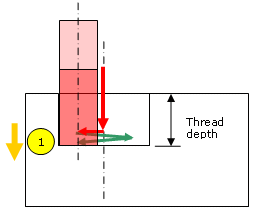 |
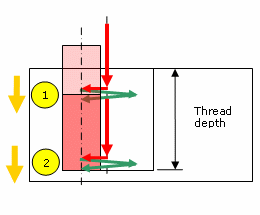 |
| Thread mill, Machining strategy=Optimized passes, Machining direction=Bottom to Top: | |
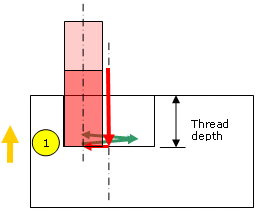 |
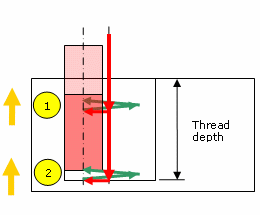 |
| Thread mill or Boring bar, Machining strategy=Mono-pass, machining direction=Top to Bottom: | |
 |
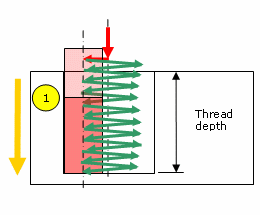 |
| Thread mill or Boring bar, Machining strategy=Mono-pass, Machining direction=Bottom to Top: | |
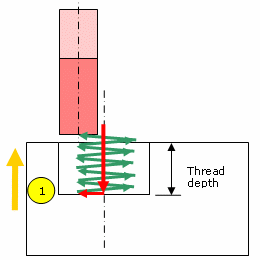 |
 |
| Machining mode Specifies the machining mode: Standard or Helical. |
| Distance between paths (Dp) Defines the maximum distance between two consecutive tool paths in a radial strategy. |
| Number of paths (Np) Defines the number of tool paths in a radial strategy. |
| Axial mode Defines how the distance between two consecutive levels is to be computed.
|
| Sequencing mode Specifies the order in which machining is to be done:
|
| Percentage overlap Specifies the percentage overlap. |
|
Automatic draft angle Specifies the draft angle to be applied on the circular flank between the top and bottom of the hole. |
| Helix mode Defines how the helix computation is to be done. The manufacturing attribute is MFG_HELIX_MODE.
|
| Compensation output Allows you to manage the generation of Cutter compensation (CUTCOM) instructions in the NC data output: The following options are proposed:
|
Axial Machining Geometry ConsiderationsGeometry parameters are managed in the Geometry tab page
Machining PatternsA machining pattern comprises two sets of data:
When you create a new axial machining operation, the New Pattern command in the list prompts you to create a machining pattern for the operation. You can add positions to this new machining pattern by clicking the sensitive text (No Point or x Points). This opens the Pattern Selection dialog box that lists all available machining and design patterns. Just select one of the existing patterns and/or select geometry in the 3D view to define the hole positions. The new machining pattern is created when you create the machining
operation. The pattern geometry and technology data is stored and the new
pattern is assigned an identifier If there are already machining patterns on previous operations, the list allows a quick selection of an existing pattern. If selected, the existing pattern is shared between the operations. You can also use the following commands in the list for assigning a machining pattern to the operation. Copy from Current: The machining pattern (geometry and technology data) is duplicated. The pattern cannot be shared. It is possible to modify the machining data in the current machining operation without impacting other operations. New from Current (share geometry): The machining pattern (geometry and technology data) is duplicated. The pattern can be shared. If the pattern is modified, all operations using it will be impacted. New Pattern: A new machining pattern is created with the geometry and technology data that you specify. Modification of a machining pattern is possible using the Machining Pattern editor only. This editor can be opened by double-clicking the machining pattern in the manufacturing view. Please refer to Machining Patterns for more information. Note that it is possible to reference in a machining pattern one or more 3D Wireframe features (that is, Projection, Symmetry, Rotation and Translation operators) containing at least one point. Pattern Ordering ModesHoles that are selected for a machining pattern can be ordered according to the following modes:
|
|||
Managing Pattern PointsContextual Menu on 'No Points / x Points' Sensitive TextA number of contextual commands are available for managing hole positions when you right click the 'No Points / x Points' sensitive text in the Geometry tab page.
Contextual Menu on Pattern PointsA number of contextual commands are available when you right-click a pattern point.
|
|||
Inversing Pattern OrderingAn Inverse pattern ordering checkbox is available in the Geometry tab page to allow an operation to locally override the ordering of the Machining Pattern by inversing it.
This option is useful in the following cases.
|
|||
Overall Tool Axis OrientationRight click the Tool axis strategy sensitive text in the Geometry tab page and select one of the following options to specify the general tool axis orientation:
Note that the tool axis orientation can be inverted by clicking the tool axis symbol in the Geometry tab page. |
|||
Projection and Top Element ModesIn the Geometry tab page you can choose between Projection and Top Element modes by clicking on the sensitive text. The following figure illustrates Projection mode. The reference pattern points are projected onto the selected part surface. The projected points and the axes normal to the surface define the hole positions to be drilled. The following figure illustrates Top Element mode. The reference pattern points define the hole positions to be drilled. The machining depth takes into account the normal distance between the reference points and the selected part surface. |
|||
Bottom PlaneIf a bottom plane is selected, the machining depth is the distance between the hole origin and its projection on the bottom plane. This machining depth is computed for each hole in the machining pattern. The depth shown in the geometry panel is the machining depth computed for the first hole. The Machine different depths setting is ignored when a bottom plane is selected. |
|||
Origin OffsetYou can specify an Origin Offset in order to shift the entire tool path by the specified amount. |
|||
Jump DistanceThe jump distance allows an extra
clearance for moving in Rapid motion between the holes to be drilled
whenever this distance is greater than the approach clearance. |
|||
Holes at Different LevelsFor 2.5-axis operations, the program automatically manages holes at different levels using horizontal transition paths. |
|||
Machining Different DepthsWhen dealing with design feature holes in design patterns, both the result and specification mode are taken into account (except Spot Drilling, Counterboring, and Countersinking operations). Select the Machine different depths checkbox in the Geometry tab page when you want the program to automatically manage different depths of holes in a pattern (result mode). If the checkbox is not selected, the program uses the values specified in the Geometry tab page for the pattern holes (specification mode). For Threading operations,
select the Machine different thread depths checkbox when you
want the program to take the real thread depth of each selected pattern
hole into account. |
|||
Relimiting Hole OriginsThe Relimit hole origin and Machine different depths checkboxes in the Geometry tab page can be used together to manage the machining strategy of different design hole configurations. In the following figures the red star ( |
|||
| Relimit
hole origin Off Machine different depths Off
|
Relimit
hole origin Off Machine different depths On
|
||
| Relimit
hole origin On Machine different depths Off
|
Relimit
hole origin On Machine different depths On
|
||
Machining Different DiametersIt is possible to machine different hole diameters in a Circular Milling operation thanks to the Machine different diameters checkbox on the Geometry tab page. If selected, the diameter specified for each position of the machining
pattern is machined. |
|||
Managing Blind and Through HolesA Machine Blind/Through checkbox is provided in the Geometry tab page. If selected, the blind/through characteristic of the hole is determined
for each position of the machining pattern. Note that the Machine Blind/Through capability is not available for user features. |
|||
Macros in Axial Machining OperationsThe Macro tab page
All types of macros used in Drilling Operations are collision checked. If a check element is specified between two machined positions, a linking macro is applied to avoid collisions. Check (or fixture) elements as well as an associated Offset on Check can be specified in the Geometry tab page. Note that some specific axial machining operations support additional macro types:
Please refer to Define Macros on an Axial Machining Operation for more information. |
|||
Editing CYCLE Syntaxes in Axial Machining OperationsFor all axial operations Edit Cycle
For example, the Cycle Syntax Edition dialog box appears when you select
Edit Cycle
You can access all the cycle syntaxes contained in the current PP table
for a Boring operation by means of PP instruction
For example, if your PP Table contains the following NC Instructions for Boring operations: / Then these syntaxes will be displayed in the PP Words Selection dialog box that appears: You can then select the desired syntax and click Apply to display it in the Cycle Syntax Edition dialog box. Just click OK to use the cycle syntax in the Boring operation being edited. Note that in the example above, the PP Table contained several PP Instructions for the same operation type: NC_BORING_1 to NC_BORING_4. Note that only one cycle syntax (delimited by In this way, a multiple choice of syntaxes is proposed at programming time. For more information please refer to Insert PP Instruction. |
|||